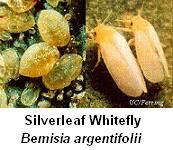
Ecke Responds to Q-Biotype Allegations
Late last week GPN Weekly learned that the California Department of Agriculture (CDFA) put a hold on one of the greenhouses at the Ecke Ranch because some suspicious whiteflies were found in one section of that house on commercial poinsettia stock plants. As reported in the past few weeks, Q-Biotype whiteflies were found at an Arizona retailer in December 2004. The suspect plant was traced back to a grower in Northern California, and it was determined that the poinsettia cuttings had come from Ecke Ranch. According to Paul Ecke III, CEO of Ecke Ranch, this is what led to an inspection of the Ranch.
Last week, the Ranch sent out a letter to its customers explaining its situation; the following is an excerpt from that letter. “Some of you may have read a recent report on a new type of whitefly that was found in Arizona in December 2004, and traced back to a California nursery. We are happy to report, that after extensive inspections at our California facility by CDFA, we were declared free of whitefly infestation as of 26 April and have no reason to believe that this biotype originated here or in our Guatemala or Mexican production facilities.
“We have had three inspections here at the Ranch, and during the last inspections they [CDFA] looked and looked and couldn’t find anything, so they declared us free of whitefly infestation. We are officially not infested with whiteflies,” said Ricardo Campos, Ecke’s western region sales manager, in an interview with GPN Weekly.
At this point there are a few conflicting reports as to whether or not there was a positive confirmation at the Ranch. Regardless, Ecke has confirmed that it destroyed all plants from the suspect greenhouse, and the Ranch has heard verbally and is expecting to hear, in writing, from the CDFA this week to let them know that they are off of the hold and may be allowed to resume shipping to Arizona, currently the only state that has implemented a quarantine on suspect California plant material.
GPN Weekly has spoken to Ecke, Campos, Lin Schmale from the Society of American Florists and Nolan Lemon, public affairs specialist at AHPIS, and they all agree that the main issue is letting growers know that APHIS is forming an ad hoc working group to include representatives of the federal and state governments, the National Plant Board, all impacted industries and the scientific community. Many people in the horticulture and agriculture industries are working together to develop the best management options for addressing this pest without regulation. “It is important for all of agriculture to work together on ways to avoid developing pesticide resistance. That is the danger; the danger is not the whitefly. We need to get the focus turned towards helping growers better use pesticides, scouting and using management methods to avoid developing resistance,” Schmale.
According to Ecke, “This is not the next SOD; this is not the next Ralstonia; this problem is going to be solved and we will be back to normal.”
“SAF and ANLA are working hard with the USDA to try and get a federal stance on this that will give the states better guidance,” added Schmale.
You may have heard rumors indicating that this biotype is more resistant to standard chemical controls and that regulating it would be very difficult because testing for biotype takes so long. Neither of these rumors can be substantiated, as conflicting research on resistance is available and regulation is still under consideration. At this point, government, scientists and industry leaders are still in the process of sorting out the implications of Q-Biotype whiteflies.
According to the letter distributed by Ecke, “The Ecke Ranch is supportive of the efforts of discovery and of the work researchers are doing to assist the industry in monitoring pesticide resistance in insect populations. We have had no problems controlling whitefly populations and see no resistance to current, typical chemicals. We continue to use and recommend to customers ‘best practices’ pest management, which includes an active scouting program, maintaining clean growing conditions and providing for sound chemical choice rotations.”
“The fact that the Q-Biotype whitefly was apparently around last fall and was recently found again at some California locations likely means there are more of them out there,” explained Jim Barrett, professor at the University of Florida and GPN’s consulting editor, “but hopefully this does not cause undue alarm on the part of growers, regulatory agencies or university researchers. While we have described the Q-Biotype as being resistant to our standard control chemicals, it is apparent that the insect is controllable, and it is not completely resistant. In Europe, where it has been around for a few years, it is not out of control, and growers are using the same chemicals we have, along with biological control measures. The locations in California are good operations, and their standard insect control strategies were keeping the whitefly under enough control that a problem was not recognized. It is clear that we will need to be much more conscientious with our whitefly control programs and not depend on a single chemical. Practicing chemical rotation and resistance management is going to move from being a ‘good idea’ to being critical for controlling whiteflies.”


 Video Library
Video Library 




















